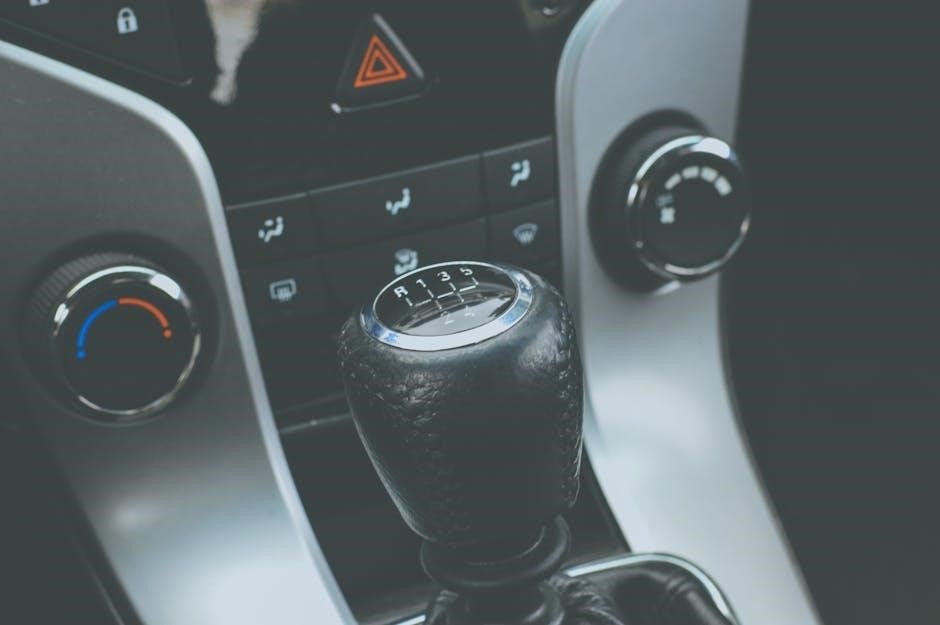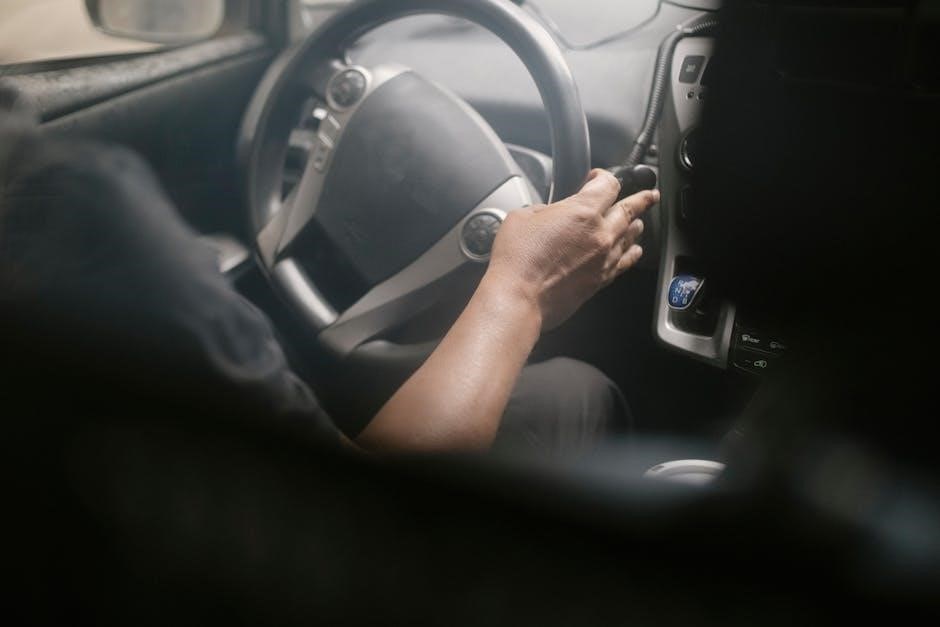The DC Driving Manual is a comprehensive guide for drivers in Washington D.C., covering rules, safe practices, and license requirements. It helps both new and experienced drivers understand traffic laws and stay safe on the road.
Overview of the DC Driving Manual
The DC Driving Manual is an essential resource for all drivers in Washington D.C., providing detailed information on traffic laws, safe driving practices, and licensing requirements. It serves as a guide for both new and experienced drivers, ensuring they understand the rules of the road and how to navigate the city’s unique traffic conditions. The manual covers topics such as right-of-way rules, speed limits, and special driving scenarios, making it a comprehensive tool for responsible and safe driving in the District of Columbia.
Importance of the DC Driving Manual for New and Experienced Drivers
The DC Driving Manual is a vital resource for all drivers, offering essential insights into Washington D.C.’s traffic laws and safe driving practices. For new drivers, it provides a foundational understanding of road rules, helping them prepare for the driver’s test and become responsible motorists. Experienced drivers benefit from updates on new regulations and refreshers on critical safety guidelines. The manual ensures compliance with local laws, promotes safe driving habits, and reduces the risk of accidents. It is a must-read for anyone aiming to navigate Washington D.C.’s unique traffic conditions confidently and responsibly.
Rules of the Road in Washington D.C.
Understanding Washington D.C.’s traffic laws is crucial for safe and legal driving. The manual outlines right-of-way rules, speed limits, and traffic signs to ensure compliance and safety.
Right-of-Way Rules and Regulations
Right-of-way rules in Washington D.C. are designed to ensure smooth traffic flow and safety. Drivers must yield to pedestrians, emergency vehicles, and public transportation. At four-way stops, the vehicle on the right has priority. When turning left, drivers must give way to oncoming traffic. Buses and bicycles also have specific right-of-way privileges. Understanding these regulations is essential to avoid accidents and violations. Always be cautious and courteous, especially in busy intersections. Familiarizing yourself with these rules will help you navigate D.C.’s roads confidently and responsibly.
Speed Limits and Traffic Signs
Speed limits in Washington D.C. vary depending on the location, typically ranging from 25 mph in school zones to 55 mph on highways. Traffic signs are standardized to guide drivers, ensuring safety and order. Regulatory signs, such as stop signs and yield signs, must be obeyed. Warning signs alert drivers to potential hazards, while guide signs provide directional information. Ignoring these signs can lead to accidents or penalties. Familiarizing yourself with these signs and adhering to speed limits is crucial for safe and lawful driving in the District. Always stay alert and follow traffic regulations to protect yourself and others.

Intersection and Lane Usage Guidelines
Understanding intersection and lane usage is crucial for safe driving in Washington D.C. Drivers must yield to pedestrians and oncoming traffic when turning or merging. Proper lane usage involves staying within marked lanes and avoiding weaving. At intersections, always follow traffic signals and right-of-way rules. When merging onto highways, match your speed to traffic and use designated merge lanes. Be cautious of bike lanes and shared-use paths, ensuring you do not encroach on them. Always signal before changing lanes or turning to maintain visibility and safety for all road users. Adhering to these guidelines helps prevent accidents and ensures smooth traffic flow.
Turning and Passing Laws
In Washington D.C., turning and passing laws are designed to ensure safety and order on the roads. Right turns on red are permitted unless otherwise posted, while left turns on red are generally prohibited. U-turns are restricted in certain areas, such as near schools or where visibility is limited. Passing is only allowed in designated zones and when safe to do so. Drivers must always yield to oncoming traffic when turning or merging. Proper signaling is mandatory before turning or changing lanes to alert other drivers. Adhering to these laws helps reduce accidents and maintains smooth traffic flow.
Driver’s Licenses in Washington D.C.
The DC Driving Manual provides detailed guidance on obtaining and maintaining driver’s licenses in Washington D.C., including eligibility, application processes, and renewal requirements for all drivers.
Types of Driver’s Licenses Available
The DC Driving Manual outlines the various driver’s licenses available in Washington D.C., including standard, commercial, and provisional licenses. It details eligibility criteria, application processes, and required documentation. The manual also covers restrictions for young drivers and special permits. Understanding the differences between license types is essential for applicants to choose the correct one for their needs. The guide ensures drivers are well-informed about the requirements and regulations for obtaining and maintaining a valid driver’s license in the District of Columbia.
Requirements for Obtaining a Driver’s License
To obtain a driver’s license in Washington D.C., applicants must meet specific requirements outlined in the DC Driving Manual. These include being at least 16 years old, providing proof of identity, residency, and Social Security number. Vision tests are mandatory, and applicants under 18 must provide parental consent. A written knowledge test is required for first-time applicants. The manual details documentation needed and steps for applying, ensuring applicants are prepared for the process. Understanding these requirements helps streamline the licensing process for both new and transferring drivers.
Renewal and Replacement Process for Licenses
The DC Driving Manual outlines the renewal and replacement process for driver’s licenses in Washington D.C. Licenses can be renewed online, by mail, or in person at a DMV office. Applicants must provide required documents, such as proof of identity and residency. A vision test may be necessary for renewal. If a license is lost or stolen, a replacement can be obtained by submitting the appropriate form and fees. The manual ensures drivers understand the steps to maintain valid licensure, avoiding penalties for expired or missing licenses. Staying informed helps drivers renew or replace licenses efficiently.

Safe Driving Practices
The DC Driving Manual emphasizes safe driving practices, including defensive driving techniques, night driving tips, and strategies for navigating inclement weather conditions to ensure road safety for all drivers.
Defensive Driving Techniques
Defensive driving is a crucial aspect of road safety in Washington D.C. It involves anticipating potential hazards and reacting appropriately to avoid accidents. Key techniques include maintaining a safe distance from other vehicles, staying alert to surroundings, and being prepared for unexpected actions by other drivers. Understanding traffic laws and signals is essential, as is avoiding distractions while driving. The DC Driving Manual emphasizes the importance of adjusting speed according to road conditions and being courteous to other road users. By mastering these techniques, drivers can significantly reduce the risk of accidents and ensure a safer driving experience.
Night Driving Safety Tips

Night driving in Washington D.C. requires extra caution due to reduced visibility. The DC Driving Manual recommends reducing speed and using low beams to avoid blinding other drivers. Ensure all vehicle lights are functioning properly and keep windshields clean to minimize glare. Avoid distractions, such as using phones, and maintain a safe distance from other vehicles. Be alert for pedestrians and cyclists, who may be harder to see at night. Stay vigilant and anticipate potential hazards, as reaction times are limited in low-light conditions. Following these tips can significantly enhance safety while driving at night in the District.
Inclement Weather Driving Strategies

Driving in Washington D.C. during inclement weather requires cautious strategies. The DC Driving Manual advises reducing speed and increasing following distances to account for reduced visibility and slippery roads. Use low beams in fog or heavy rain to avoid blinding others. Ensure tires and brakes are in good condition for better traction and stopping power. Avoid sudden movements, such as hard braking or sharp turns, which can lead to skidding. Keep windshield wipers and defrosters in proper working condition to maintain clear visibility. If possible, delay travel during severe weather conditions to ensure safety on the road.

Traffic Laws and Violations
The DC Driving Manual outlines traffic laws and violations to ensure safe driving. It covers penalties for speeding, reckless driving, and other infractions, helping drivers avoid fines and stay compliant.
Common Traffic Violations and Penalties
The DC Driving Manual highlights common traffic violations such as speeding, reckless driving, and failure to obey traffic signs. Penalties include fines, license points, and potential suspension. Speeding fines range from $50 to $300, while reckless driving can lead to criminal charges. Running red lights or stop signs may result in $200 fines and 3 points. Accumulating 12 points within two years can suspend a driver’s license. Understanding these violations and penalties is crucial for safe and lawful driving in Washington D.C., ensuring compliance with traffic laws and avoiding severe consequences.
Understanding Traffic Tickets and Fines
Traffic tickets in Washington D.C. are official notices issued for violations of traffic laws. They include details like the offense, fine amount, and due date for payment or response. Fines vary based on the severity of the violation, with penalties ranging from $50 to $1,000 or more for serious offenses. Drivers can pay fines online, by mail, or in person, or contest the ticket in court. Ignoring a ticket may result in additional penalties, including license suspension. The DC Driving Manual provides guidance on understanding and addressing traffic tickets to ensure compliance and avoid further consequences.
Special Vehicles and Driving Scenarios
The DC Driving Manual addresses unique challenges for motorcycles, commercial vehicles, and emergency situations. It provides safety guidelines and regulations for operating these vehicles in Washington D.C.
Motorcycle Driving Laws and Safety
Motorcycle drivers in Washington D.C. must adhere to specific safety laws. All riders are required to wear Department of Transportation (DOT)-approved helmets. Motorcycles must have proper lighting and brakes.
Lane splitting is prohibited, and motorcyclists must stay within single lanes. The DC Driving Manual emphasizes defensive driving techniques for motorcyclists, such as maintaining safe distances and being visible to other drivers.
Additionally, motorcyclists must carry valid insurance and ensure their vehicles meet state safety inspections. Following these guidelines helps reduce accidents and enhances road safety for all users.
Commercial Driver’s License (CDL) Requirements
To obtain a Commercial Driver’s License (CDL) in Washington D.C., applicants must meet specific requirements. Eligibility includes being at least 21 years old, providing proof of residency, and passing a vision test.
Applicants must also submit medical certification and complete a background check for certain endorsements. The DC Driving Manual outlines three CDL classifications: Class A, B, and C, each requiring a written test and skills test.
Additionally, endorsements for hazardous materials or passenger vehicles require specialized testing. Adhering to these requirements ensures safe and legal commercial driving in the District of Columbia.
Preparing for the Driver’s Test
Preparing for the driver’s test involves studying the DC Driving Manual, taking practice tests, and understanding traffic laws. Effective preparation ensures confidence and success.
Study Materials and Resources
The DC Driving Manual is the primary study resource for drivers, offering detailed information on traffic laws, signs, and safe driving practices. Additional resources include online practice tests, interactive guides, and mobile apps designed to help learners prepare effectively. The manual is available in multiple formats, including digital versions for easy access. Utilizing these materials ensures a thorough understanding of Washington D.C.’s specific driving rules and regulations, helping applicants prepare confidently for their driver’s test.
Practice Tests and Exam Preparation Tips

Practice tests are essential for preparing for the DC driver’s exam. They simulate real test conditions, helping applicants assess their knowledge and identify areas for improvement. The DC Driving Manual offers sample questions and interactive tools to enhance study sessions. Tips include reviewing the manual thoroughly, focusing on common traffic scenarios, and using online resources for additional practice. Applicants should also time themselves during practice tests to build confidence and reduce anxiety. Utilizing these strategies ensures a well-prepared approach to the actual exam, increasing the likelihood of success.

Local Driving Tips and Considerations
Washington D.C.’s unique traffic conditions require careful planning and awareness. Be prepared for heavy traffic, pedestrian activity, and construction zones. Understand local traffic patterns and parking rules to navigate efficiently.
Driving in Washington D.C.’s Unique Traffic Conditions
Driving in Washington D.C. presents unique challenges due to its heavy traffic, dense pedestrian activity, and frequent construction zones. The city’s grid system can be confusing, especially for newcomers. Be prepared for sudden stops and lane changes. Construction zones often cause detours, so staying updated on road closures is essential. Additionally, rush hour traffic is severe, particularly during weekdays from 7-9 AM and 4-6 PM. Drivers should allow extra time for commutes and remain vigilant in busy areas like downtown and near tourist attractions. Understanding these conditions helps navigate the city safely and efficiently.
Parking and Roadside Regulations
Parking in Washington D.C. requires careful attention to signs and regulations. Residential parking permits are often required in neighborhoods, while metered parking is common in commercial areas. Drivers must adhere to time limits and payment rules to avoid fines. Commercial vehicles have specific parking zones and may need special permits. No-parking zones are strictly enforced, especially during rush hours. Roadside regulations include restrictions on stopping or standing in certain areas, particularly near intersections or bus stops. Always check traffic signs before parking to ensure compliance with local laws and avoid penalties.

Conclusion
The DC Driving Manual provides essential guidance for safe and responsible driving in Washington D.C. By following its rules and practices, drivers can ensure a secure and enjoyable experience on the road.

Final Tips for Safe and Responsible Driving in Washington D.C.
Always stay alert and follow traffic laws to ensure safety on Washington D.C.’s roads. Yield to pedestrians and cyclists, and use defensive driving techniques. Avoid distractions while driving, especially in heavy traffic areas. Be cautious during night driving and inclement weather, reducing speed as needed. Respect traffic signs and signals, and never ignore parking regulations. Continuous learning and adherence to the DC Driving Manual will help you navigate the city’s unique traffic conditions responsibly. Safe driving practices protect not only yourself but also other road users, making the roads safer for everyone.
